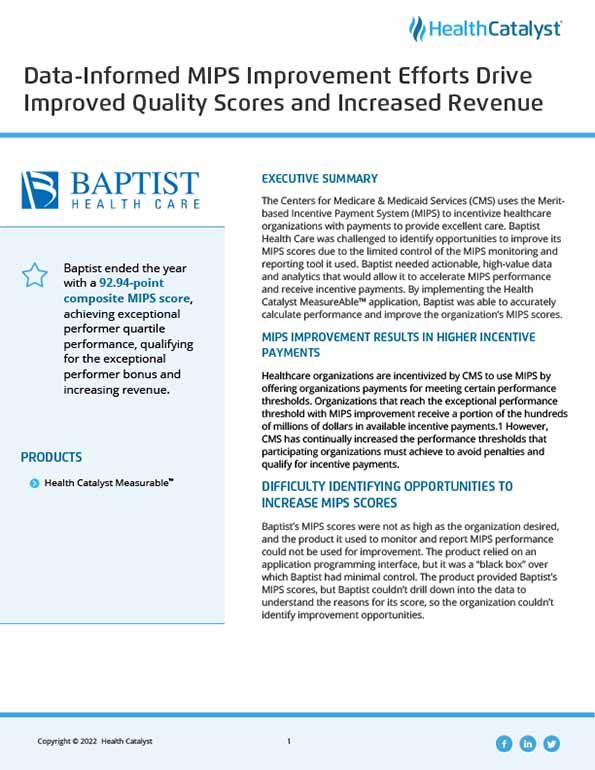The Centers for Medicare & Medicaid Services (CMS) uses the Merit-based Incentive Payment System (MIPS) to incentivize healthcare organizations with payments to provide excellent care. Baptist Health Care was challenged to identify opportunities to improve its MIPS scores due to the limited control of the MIPS monitoring and reporting tool it used. Baptist needed actionable, high-value data and analytics that would allow it to accelerate MIPS performance and receive incentive payments. By implementing the Health Catalyst MeasureAble™ application, Baptist was able to accurately calculate performance and improve the organization’s MIPS scores.
Healthcare organizations are incentivized by CMS to use MIPS by offering organizations payments for meeting certain performance thresholds. Organizations that reach the exceptional performance threshold with MIPS improvement receive a portion of the hundreds of millions of dollars in available incentive payments.1 However, CMS has continually increased the performance thresholds that participating organizations must achieve to avoid penalties and qualify for incentive payments.
Baptist’s MIPS scores were not as high as the organization desired, and the product it used to monitor and report MIPS performance could not be used for improvement. The product relied on an application programming interface, but it was a “black box” over which Baptist had minimal control. The product provided Baptist’s MIPS scores, but Baptist couldn’t drill down into the data to understand the reasons for its score, so the organization couldn’t identify improvement opportunities.
When the organization made process changes, it took weeks for the data to make its way through the system and for scores to update, making it difficult—and at times impossible—to evaluate the impact of process changes on outcomes. Furthermore, Baptist had minimal control over submission data and was unable to maximize MIPS scores and ensure the points assigned accurately reflected the expert care provided to its patients. The organization needed actionable, high-value data and analytics that would allow it to accelerate MIPS performance.
To meet its need for actionable, robust, high-value data and analytics for both MIPS reporting and improvement activities, Baptist decided to sunset the previous product used at the organization and implement the Health Catalyst MeasureAble application. MeasureAble is a quality measures solution that combines complete data, measures, visualizations, and workflows (measurement, improvement, and submission) into one comprehensive system. MeasureAble calculates performance, displays a measure performance dashboard, and includes a submission engine that submits data directly to CMS.
After implementing MeasureAble, Baptist now has a single, actionable source of truth for MIPS. The comprehensive measures engine and data visualization dashboard allows Baptist to proactively monitor complete performance metrics across different levels of the organization. Baptist uses the analytics application as part of its daily operations to:
With this data, the Baptist teams have the option to perform pre-visit planning activities to determine any gaps in care prior to the patient visit and is currently being used to identify any patient exceptions to the measures to accurately opt them out of the measure to impact performance. Additionally, Baptist visualizes performance for each measure, including current performance and the number of gaps that must be closed to meet improvement goals. The organization can drill down to the provider, population, and patient level, gaining actionable insights to close gaps and improve MIPS performance.
Using the analytics application, Baptist can identify why gaps were occurring and then intervene to correct performance. For example:
"MeasureAble gives us actionable data that we can use to drive performance improvement, maximizing our MIPS scores."
- Sara Brown, MBA, Practice Optimization Consultant, Baptist Health Care
Baptist’s data-informed MIPS improvement efforts are delivering the desired results. The organization achieved the following results:
Baptist continues to leverage the analytics application for improvement and is engaging specialty providers in improvement efforts. The organization is confident it will achieve the exceptional performance quartile again next year and bring in increased revenue by qualifying for MIPS incentives.


